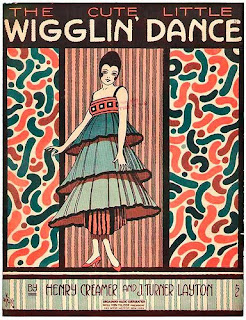 I had a few moments during lunch today so I set out to harvest some graphics for the blog. I'm like a Viking when it comes to old graphics. I set forth in my computerized longboat, scouring the shores of distant lands for old ads, articles, paintings, and the like which I can loot. Then I return to my little cyber-village with my hoard, happy and ready to feast. You've seen the results of some of these forays – adulterated ads from the 40's and 50's that don't promote anything but a general sense of weirdness. It's fun and it satisfies my penitent for graffiti without requiring spray paint or the chance of going to jail.
I had a few moments during lunch today so I set out to harvest some graphics for the blog. I'm like a Viking when it comes to old graphics. I set forth in my computerized longboat, scouring the shores of distant lands for old ads, articles, paintings, and the like which I can loot. Then I return to my little cyber-village with my hoard, happy and ready to feast. You've seen the results of some of these forays – adulterated ads from the 40's and 50's that don't promote anything but a general sense of weirdness. It's fun and it satisfies my penitent for graffiti without requiring spray paint or the chance of going to jail.Well, today I found myself on the waters of old sheet music and I started perusing cover art. There is some amazing cover art for the music of the teens, twenties, and thirties. After that it all becomes muggy headshots of Sinatra or Elvis done in low res on a purple or blue or pink background. The ragtime era stuff is much more inventive if you can stomach occasional racist imagery and titles. I tend to like the covers with a deco flare and that (along with the weird title) drew me to the piece of sheet music I'm writing about today.
"The Cute Little Wigglin' Dance" had me at 'wigglin' dance'. I mean, that's such a visual: what exactly is the wigglin' dance? What sorts of steps does it have? On what occasion would you do the wigglin' dance? Part of me thinks it’s a great euphemism for really having to pee yet another part of me wants to make it a lot bawdier. You know the Victorians came up with names for body parts just so they wouldn't have to say 'leg' in public so maybe it's no different with wigglin' dance?
The artwork's got it all. Look at that bullet hat the poor girl's wearing. Is she dancing or is she about to be shot from a cannon? She's dressed in some kind of triple-decker dervish dress that's flaring out in spite of the fact she seems to be standing still. Maybe each layer is supported by some kind of cantilever system? Maybe this is a whole new and sadistic use of underwire? Of course, in the teens definition of modesty she's wearing an ankle-length underskirt in spite of the fact the bottom layer of her dress extends past her knees. Wouldn't want anyone thinking she's got loose morals – even if they might mistake her for an extra off the last Flash Gordon movie. Hey, at least she's wearing sensible shoes. Oh, and did you notice she's surrounded by huge mutant bacteria? Maybe the wigglin' dance is actually the last stage in some horrid, early 20th century plague that claimed the lives of youth during the ragtime era? Maybe this woman is dressed in the traditional garb of a culture that was wiped from the face of the earth by the unstoppable advance of the wigglin' dance epidemic of 1919? Only this bit of paper remains to tell of their once glorious civilization.
The song's architects actually have a pedigree worth mentioning. John Turner Layton (1894 – 1978) penned the music for "Way Down Yonder in New Orleans" in 1922 (used in an Astaire/Rogers dance number in the film The Story of Vernon and Irene Castle (1939)) and "Whoa Tillie" (1923) which was popularized by Bessie Smith. Layton also performed in Vaudeville and eventually moved to England where he performed up into the 1960's. Henry Creamer (1879 – 1930) was the lyricist of the pair, writing the words to such songs as "After You've Gone" which Sophie Tucker popularized. In 1924 when he parted company with Layton, Creamer teamed with pianist James P. Johnson and contributed to such songs as "Alabama Stomp" and Ruth Etting's "If I Could be You". Creamer founded Club Clef with James Reese Europe in 1920.
I found the song on Rhapsody. It was performed by the Frisco Jass Band (no, not a typo, it's supposed to be 'ss'). It's a bouncy piece (I guess a wigglin' dance should be bouncy) with a sloppy trombone bit and a New Orleans feeling clarinet. Unfortunately, the version I heard didn't include any lyrics but I imagine they'd be the sort of words that would strike Bertie Wooster as 'pippy'. I'll never know, I guess. For now the lyrics are lost to time and maybe that's just as well. Sometimes when you actually reach back into the past and get hold of something like The Cute Little Wigglin' Dance you come back disappointed; it turns out to be less than you imagined. I won't stop looking though because I've got to know how Creamer described his 'wigglin' dance'. Hey, who knows what else I might find while I'm looking!

No comments:
Post a Comment